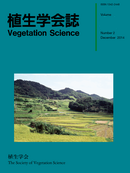Relation between spring wheat (Triticum aestivum L.) production and vegetation types were investigated in the saline soil areas of Huang-Huai-Hai Plain, China. The total of 23 quadrats were sampled and six plant communities were classified by tabular sorting and rearrangement : Salsola collina-Eriochloa villosa community, Suaeda glauca community, Lactuca tatarica- Suaeda heteroptera community, Phragmites communis community, Suaeda heteroptera community, and Suaeda heteroptera-Aeluropus littoralis community. These communities were consisted of only 20 species in total, most of stands had five species or less, and some of them were characterized by one or two dominant species. Some soil properties of the soil were compared between classified communities. The soil salinity was the highest in S. heteroptera-A. littoralis community (0.74%), followed by S. heteroptera community (0.48%), P. communis community (0.42%), L. tatarica-S. heteroptera community (0.27%), S. glauca community (0.24%) and S. collina-E. villosa community (0.06%). The rank for sodium, chlorine and sulfate content between the communities was roughly consistent with that of soil salinity. Content of potassium, calcium and magnesium was the lowest in S. collina-E. villosa community. The yields of spring wheat were measured by the plant height, the number of ear, the ear weight and the 1000-grain weight for each experimental fields that are independently established within the typical areas of each plant community. These measurements showed negative correlation between the yields of spring wheat and salt, Na, Cl, SO_4 in soil. The yields of spring wheat drastically decreased at 0.3% of soil salinity. It was concluded that adequate amount of wheat yields can be expected from both S. collina-E. villosa community and S. glauca community, whereas hardly any wheat harvest was expected from the other four communities.
View full abstract
